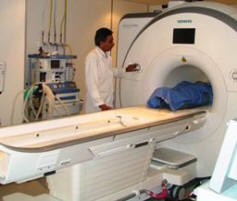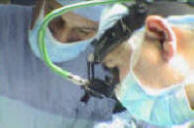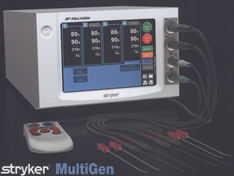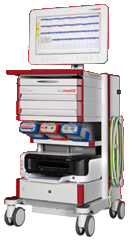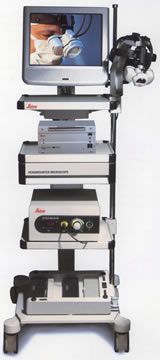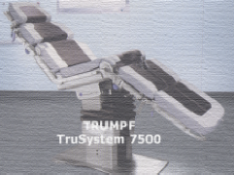|
GLYCEROL RHIZOTOMY
The goal of surgical treatment of tic
douloureux, even in elderly and medically infirm patients, remains the
production of pain relief without significant facial sensory loss and
without undue surgical risk. Percutaneous transovale trigeminal
rhizotomy by injection of glycerol into the retrogasserian cistern of
Meckel's cave is a useful alternative treatment for tic douloureux. The
major advantages of glycerol rhizotomy include (1) significant reduction
in postoperative facial deafferentation and its sequelae when compared
to differential thermal rhizotomy performed by graded radio-frequencyinduced
lesions; (2) simplification of technique by elimination of
intraoperative sensory testing and sophisticated lesion generators; and
(3) precise anatomic placement of glycerol on the basis of the results
of intraoperative trigeminal water-soluble-contrast cisternography. The
effects and mechanism of relief after glycerol injection have been
studied in detail.
History
Jefferson used glycerol as an agent to
convey phenol, a potent neurolytic alcohol, into the trigeminal cistern
for chemical ablation of the trigeminal ganglion and nerve. The
discovery that glycerol alone is effective in the treatment of tic
douloureux resulted from a serendipitous observation by Hẳkanson. During the preparation of several patients for stereotactic irradiation
of the trigeminal ganglion using the multisource cobalt 60 unit ("Gamma
knife"), Hẳkanson introduced glycerine mixed with tantalum dust into
the trigeminal cistern to provide a permanent radiographic target.
Surprisingly, relief of trigeminal neuralgia occurred in the interval
between the radiologic localization of the target and the production of
the stereotactic lesion. Hẳkanson subsequently demonstrated the proper
technique for roentgenographic definition of the trigeminal cistern with
the water-soluble contrast agent metrizamide. The development of the
technique of percutaneous retrogasserian glycerol rhizotomy and the
results after treatment of 100 patients have been reported. After a
follow-up of between I and 6 years, Hẳkanson indicated that 96 percent of
patients were rendered painfree after an initial injection, although
pain recurred in 31 percent. After the reinjection of 16 patients, a
total of 77 percent of patients were pain-free, and an additional 19
percent had only residual mild symptoms controlled with medication.
Technique
The procedure is performed with the
patient awake after light premedication with 50 to 100 mg of
intramuscular hydroxyzine hydrochloride. Addition of an anticholinergic
agent (atropine sulphate 0.4 mg) has reduced vasovagal symptoms during
the procedure, Intravenous fentanyl (1 to 2 ml) and medazolam is given
in the operating room prior to the insertion of the needle and again
just prior to glycerol injection. Short-acting intravenous barbiturate
(methohexital sodium) administration is often valuable during needle
placement or injection. The procedure is done with the patient supine
on an electrically controlled operating room table with the suboccipital
region of the patient supported by a cerebellar headrest. A C-arm
fluoroscopic image intensifier equipped with image storage capacity
(video disc recorder) is positioned in the anteroposterior (AP) skull
projection. Only AP and lateral projections are used, since neck
hyperextension for submentovertex views is often difficult for elderly
patients and since the foramen ovale is usually identified in the AP
projection.
Most patients are taken to surgery after
admission to the hospital on the day of the scheduled procedure. After
local 1% lidocaine infiltration of the skin, the spinal needle is
inserted through the cheek 2.5 cm lateral to the corner of the mouth and
directed toward a point 2,5 cm anterior to the external auditory canal
(patient superior-inferior and anterior-posterior coordinates) and
toward the medial aspect of the ipsilateral orbit (patient left-right
coordinate). Deep injection of 1ml of lidocaine just
exterior to the foramen ovale allows relatively painless transovale penetration, After fluoroscopy confirms the appropriate location of the
needle, the stylet is removed to observe CSF flow. When a standard
spinal needle is properly placed, the hub frequently rests against the
skin of the cheek. Free CSF flow is highly desirable, although
demonstration of CSF does not exclude the possibility of subtemporal
needle placement. When glycerol injection is attempted after prior
destructive procedures of the trigeminal nerve, CSF flow may vary from
only several drops to brisk flow.
The patient
is placed in the semi sitting position with the neck slightly flexed, A
1-ml syringe is used to inject 0.1 to 0,5 ml of sterile nonionic water
soluble iodine contrast medium under fluoroscopy. The roentgenographic
appearance of the trigeminal cistern is variable, but often an ovoid
filling defect can be noted on the lateral projection. The
retrogasserian fibers are identified on AP and lateral fluoroscopy. Subdural injection requires repositioning of the needle or
replacement with a second needle. When the needle is advanced too far,
contrast material can exit immediately through the trigeminal porus into
the posterior fossa and can layer out along the petrous ridge. It may
also be injected into the cavernous sinus. Layering out of the contrast
agent beneath the temporal lobe can be demonstrated when the needle is placed in a too lateral
position, or occasionally after a prior subtemporal operation has
distorted the normal cistern anatomy. Inability to successfully
demonstrate the trigeminal cistern precludes further attempts at
glycerol injection, unless the needle can be redirected to obtain more
typical cisternal findings. The cistern size is estimated by recording
the volume of the contrast material just before it escapes from Meckel's
cave into the posterior fossa. In 90 percent of patients, the total
cistern volume has been less than 0.34 ml, and no cistern larger than
0.6 ml has been seen. The contrast material is
evacuated by allowing it to flow from the needle. In order to completely
evacuate the cistern, it is often necessary to place the patient in the
Trendelenburg position with the neck extended, to allow residual minute
amounts of the contrast agent to escape into the posterior fossa. After
this manoeuvre, the patient is returned to the semisitting position.
Sterile undiluted 99.9% anhydrous glycerol is mixed with small amounts of sterile radiopaque
tantalum dust. The glyceroltantalum combination is injected slowly into
the cistern. The radiopacity of the combination allows further
intraoperative confirmation of proper placement of the glycerol. If the
pain recurs, a permanent marker of the trigeminal cistern has been
established to facilitate further treatment.
The volume of glycerol injected depends on
the affected divisions of the nerve and the volume of the cistern.
Mandibular and maxillary division pain have been treated satisfactorily
with 0.15 to 0.3 ml. Ophthalmic division fibers have been treated
selectively by allowing a small residual amount of contrast material to
layer out on the floor of the cistern. Glycerol could then be "floated"
on top of the metrizamide, an agent heavier in concentration than
glycerol, which is in turn heavier than the CSF. After removal of the
needle, the patient is transferred in a sitting position with neck
continually flexed to a hospital bed and remains sitting for 2 h.
Thereafter, the patient resumes normal activity. Patients are
discharged on the first postoperative day. Prior medications are
tapered off gradually on an outpatient basis over 5 to 10 days.
Trigeminal sensation is tested at 24 h and 6 weeks after injection.
Patient Data
All patients
are usually refractory to or intolerant of medical therapies such as
carbamazepine, baclofen, phenytoin, and clonazepam, used alone or in
combination. Fifty-eight percent has right-sided pain and 42 percent has
left-sided pain; 8 percent has bilateral symptoms. The ophthalmic
division usually affected in 25 percent of patients, the maxillary division
in 43 percent, and the mandibular division in 60 percent. Many patients
has more than one division affected. Prior surgical management was
performed in 41 percent, all of whom had inadequate
pain control before glycerol rhizotomy.
Microvascular decompression is
usually reserved for those
patients who are less than 65 years old and who are in general good
health. Glycerol rhizotomy is performed as the initial surgery in
patients with multiple sclerosis or for those whose concomitant medical
illnesses make them poor candidates for general anesthesia and
craniotomy.
Results
Immediate pain relief after the first glycerol
rhizotomy usually obtained in 90 percent; 10
percent has initial technical failures due to an
inability to define the trigeminal nerve fibers during
contrast cisternography, due to subtemporal or subdural
glycerol injection, or due to insufficient glycerol
injection for the size of the cistern or the divisions
affected by pain. 71 percent having one procedure, 21
percent- two, 7 percent- three, and 1 percent undergoing four glycerol rhizotomies. Long-term pain relief after one or more
glycerol procedures is found in 55 percent of patients and 22
percent having pain control with medication, repeat rhizotomy. or other surgical
procedures 23 percent have inadequate pain relief.
Complications:
According to Lunsford L.D in early operative
complications, one patient died (0.2
percent) in the recovery room immediately after undergoing
glycerol rhizotomy. The patient complained of immediate
chest pain after injection and was noted to develop electrocardiographic changes compatible with an acute
myocardial infarction. Twenty minutes later she died from
cardiac arrest. Postoperative headache was noted in 15
percent. nausea or vomiting in 8 percent, vasovagal symptoms
(bradycardia and hypotension reversible with atropine
sulphate ) in 15 percent. and hypertension (to levels of 180
to 220 systolic) in up to
20 percent. The frequency of such symptoms reinforced
the value of performing glycerol rhizotomy in the
controlled environment of a properly equipped
neurosurgical operating room with an anesthesiologist
present at all times.
During the first 3 days
after rhizotomy. aseptic meningitis could be confirmed by
cerebrospinal fluid analysis in 0.6
percent. Tantalum powder could be the cause since switching to
sterilization of the tantalum powder with steam rather
than ethylene oxide. Water soluble
non ionic iodine contrast agents (300 mg iodine per ml)
still in use for intraoperative contrast cisternography. The risk of
development of postoperative herpes simplex perioralis
was noted in 37 percent:
the onset of cold sores 2 to 5 days after glycerol
rhizotomy. Perioperative administration
of acyclovir ointment to the lip region in those
patients who reported a history of cold sores during the
preoperative screening examination must be considered.
The development of
trigeminal sensory loss in patients after one or more
glycerol rhizotomies and at the time of follow-up.
49 percent have no demonstrable sensory loss (light
touch or pain). 32 percent will have mild sensory loss.
13 percent- moderate sensory loss, and 6
percent- severe loss. Deafferentation pain
characterized as annoying paresthesia or dysesthesia
were seen in 1.2% of patients. No patient in Lunsford
series,
developed anesthesia dolorosa.
Predictors of Success
The best results are
obtained when patients undergo glycerol rhizotomy as
the first surgical procedure. and thus do not represent
failures of prior surgical management. During the
glycerol procedure itself, several features can be
identified that are highly associated with an early
successful outcome (i.e.. complete pain relief within 7
to 10 days): easy penetration of the needle through the
foramen ovale, return of cerebrospinal fluid, normal
appearance of the trigeminal postganglionic fibers on
anteroposterior and lateral radiographic contrast
cisternography, easy evacuation of the contrast agent,
ipsilateral ophthalmic or maxillary pain with injection
of the glycerol, systemic physiologic signs such as
bradycardia/ hypotension or hypertension, ipsilateral axoaxonic reflexes such as a facial skin blush, and
normal appearance of the trigeminal cistern at the
conclusion of the glycerol/tantalum instillation. If all
these factors were present intraoperatively. 99 percent
of the patients can have pain relief within 5 days,
regardless of prior procedures or etiology of the pain.
Predictors of Failure
Percutaneous
retrogasserian glycerol rhizotomy should be considered
only for those patients with typical trigeminal neuralgia. Atypical facial pain, the success rate for such patients
must be extremely small. In addition. the potentially
neuroablative effects of glycerol increase the risk of
adverse and usually untreatable deafferentation
sequelae in these patients. The
most likely associated intraoperative sign associated with failure
of glycerol rhizotomy is an abnormal trigeminal cistern.
Failure to identify the cistern during
contrast injection is almost always associated with incomplete pain
relief. Subdural or infratemporal contrast injection requires
repositioning of the needle into the actual trigeminal cistern; the
cistern may lie only 1 to 2 mm away from the subarachnoid space
underneath the temporal lobe.
Failure to calculate the volume of the
cistern accurately, thereby leading to insufficient glycerol
injection for the volume or the trigeminal divisions affected, will
lead to incomplete relief. Escape of the glycerol into the posterior
fossa, a result that develops occasionally during transfer of the
patient to the stretcher at the conclusion of the procedure, leads
to failure. The patient must have the glycerol injected in the semi-sitting position with the neck flexed; he or she must remain in this
position for approximately 2 h in order to ensure the appropriate
response.
Deafferentation sequelae are
relatively rare after glycerol rhizotomy. Trigeminal sensory loss
increased with repeated procedures. After the first procedure,
approximately 20 percent of patients had detectable sensory loss,
almost always mild. With each successive procedure the risk of
sensory loss doubled, probably related to the increasing number of
trigeminal fibers damaged by the neurolytic effect of glycerol.
Patients with multiple sclerosis has
the same chance of initial success as do patients with trigeminal neuralgia due to other
causes; however, the chance of relapse seemed greater. Recurrence of
trigeminal pain in multiple sclerosis patients may reflect the
ongoing demyelinating process that may affect them. Glycerol rhizotomy
was reported in one patient with an arteriovenous malformation
of the cerebellopontine angle; this patient remained pain-free for
11 years and in two of four
patients with meningiomas of Meckel's cave that caused their
trigeminal neuralgia; in both patients the cistern was identified
and was normal despite the contiguity of the tumor.
Trigeminal Evoked Potential (TEP)
Recordings
Pre- and postoperative trigeminal
evoked potentials (TEPs) obtained after gum stimulation have remained normal after successful surgery
in 10%.
90% has abnormal ipsilateral TEPs, recorded 6 weeks to 6
months after surgery. No patient have deterioration or improvement in
the TEP recordings after then.
Experimental Studies
The mechanism of pain relief and the
effect of injection of glycerol into the trigeminal nerve are under
evaluation. Both neurolytic and osmotic effects have been
proposed. Extraneural application of glycerol to the sciatic
nerve of rats, as well as injection of glycerol into the rat
sciatic nerve, results in extensive myelin disintegration and
axonal swelling and degeneration. Hẳkanson contends
that small myelinated and unmyelinated fibers appear to be less
vulnerable than large fibers to glycerol, and that this feature may
be essential in the mechanism of pain relief after trigeminal
glycerol injection. In other studies of the effects of
gasserian and retrogasserian injection of glycerol in cats. TEPs
were recorded before, immediately after. and at 4 to 6 weeks after
the retrogasserian injection of minute amounts of anhydrous glycerol
(0.05 ml) and were compared with TEPs from the contralateral
trigeminal nerve which served as a control in each cat (after an
injection of 0.05 ml of normal saline. Histologic studies of the
trigeminal ganglion and nerve were performed. In 10 cats 4 to 6
weeks after injection, no consistent reduction in the TEPs was noted
on the injected side on follow-up, although the histologic studies
disclosed extensive areas of myelin degeneration and axonal swelling
in the nerves injected with glycerol. It seems likely
that glycerol
injection results in destruction of
the trigeminal nerve similar to that produced by thermal rhizotomy
but perhaps of lesser degree.
Discussion
Percutaneous retrogasserian glycerol
rhizotomy (PRGR) is a safe and effective alternative to other
surgical treatments of trigeminal neuralgia. When compared with differential thermal rhizotomy by
radio-frequency-induced lesions, PRGR is
simpler to perform. is less painful, can be done with the patient
under light premedication and local anesthesia, and does not require
sophisticated lesion generators or intraoperative patient sensory
testing. Successful penetration of the foramen ovale, proper
intracisternal needle placement verified by contrast cisternography.
and selective treatment of both upper and lower division trigeminal
pain are possible with the glycerol technique. The incidence of
postoperative facial sensory loss is significantly less than that
associated with thermal or other chemical rhizotomies. Patients with
tic douloureux associated with multiple sclerosis as well as with
other causes also respond to PRGR in most cases.
Hẳkanson's carefully performed
assessment of 100 patients treated with this technique demonstrated
that up to 96 percent of patients could be rendered pain-free after
one injection. although 31 percent relapsed when followed between 1
and 6 years. The vast majority of the relapsed patients developed
recurrent pain in his series within 2 years after injection. After
16 patients were reinjected, 77 percent remained completely
pain-free and 19 percent had only residual mild symptoms controlled
with drug therapy. Ninety-six percent of patients were thought to
have satisfactory relief.
Glycerol is a weak neurolytic alcohol that is a normal constituent
of human plasma. In sufficient strength (99.9% anhydrous form).
it seems to have a selective neuroablative effect on the large
myelinated fibers that are already damaged by the pathologic process
that initiates trigeminal neuralgia. It is not surprising therefore
that it seems to have equally satisfactory results in patients who
have demyelinating disease and those that are suspected of having
vascular crosscompression as an etiology. Repeated procedures with
glycerol lead to further nerve fiber damage that is manifested by
the development of cumulative sensory loss.
Trigeminal neuralgia is often a
dynamic process: some patients seem to have long-term remission of
their pain with a single procedure, while others will require a
variety of medical and surgical therapies in order to remain
comfortable for long periods. Spontaneous remission of the pain is
not infrequent. although over the years the duration of the
remissions usually lessens and the severity of the pain during
exacerbations often worsens. No set painfree interval seems to
guarantee lasting pain relief. It happens that recurrent pain develop
more than 10 years after an initially successful glycerol rhizotomy.
Since glycerol rhizotomy is a symptomatic therapy designed to
eliminate the fibers implicated in the mechanism. but does not
eliminate the etiologic causes. it is not surprising that pain
relapses occur.
The
vast majority of symptomatic trigeminal neuralgia patients either
can be rendered pain-free or can become satisfactorily controlled
with tolerable medications after glycerol rhizotomy. Refractory
pain can be treated by repeating the procedure as needed. The permanent marker of the trigeminal
cistern supplied by tantalum powder permits easy identification of
the cistern during repeat procedures. Cerebrospinal fluid can be
identified in 90 percent of patients undergoing the first procedure:
if a third procedure is eventually required. approximately 50
percent of patients have good CSF flow after intracisternal needle
placement. Repeat glycerol rhizotomy can still be successful if the
cistern is identified during contrast injection. We have found a few
patients with typical trigeminal neuralgia who seem very refractory
to a wide variety of medical and surgical options. Glycerol rhizotomy can be successful in such patients provided that the
cistern is still normal. For those patients who fail glycerol rhizotomy. selective nerve section, microvascular decompression,
balloon inflation. and radiosurgical ablation can be considered. At
present, PRGR should be considered in older or medically infirm
patients who require a simple and relatively rapid treatment. in
those patients whose postoperative facial deafferentation is to be
minimized. and in patients with upper division trigeminal pain. for
whom thermal rhizotomy may carry distinct risks of injury to corneal
sensation.
Failure of glycerol rhizotomy is
frequently due to technical features, including (1) prior surgical
procedures that obliterate the trigeminal cistern: (2) subdural
injection or infratemporal placement of the needle: (3)
insufficient volume of glycerol injected to affect the desired
trigeminal divisions. The long-term effects of intracisternal
injection of glycerine mixed with tantalum dust are now known: no significant sequelae have been noted.
Postoperative skull films continue to demonstrate the retrogasserian
fibers impregnated with tantalum dust long after treatment. Although
the symptoms of tic douloureux can be relieved in most patients by
trigeminal glycerol injection. experimental studies indicate that
the effect is probably dependent on demyelination within the
trigeminal nerve. However. the absence of significant postoperative
facial sensory loss in patients suggests that tic douloureux can be
treated effectively by a "minimal" lesion produced by glycerol.
|
